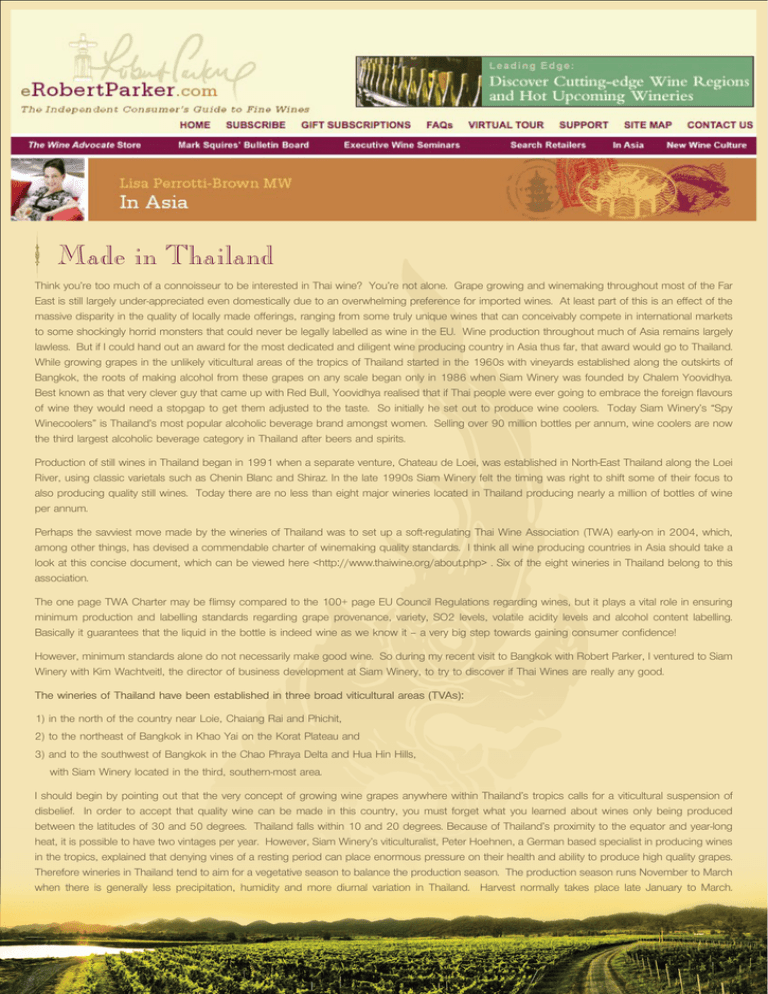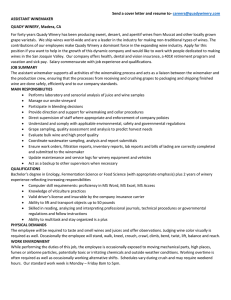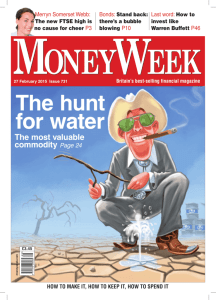082710-present MV eRobert Parker
advertisement

Made in Thailand Think you’re too much of a connoisseur to be interested in Thai wine? You’re not alone. Grape growing and winemaking throughout most of the Far East is still largely under-appreciated even domestically due to an overwhelming preference for imported wines. At least part of this is an effect of the massive disparity in the quality of locally made offerings, ranging from some truly unique wines that can conceivably compete in international markets to some shockingly horrid monsters that could never be legally labelled as wine in the EU. Wine production throughout much of Asia remains largely lawless. But if I could hand out an award for the most dedicated and diligent wine producing country in Asia thus far, that award would go to Thailand. While growing grapes in the unlikely viticultural areas of the tropics of Thailand started in the 1960s with vineyards established along the outskirts of Bangkok, the roots of making alcohol from these grapes on any scale began only in 1986 when Siam Winery was founded by Chalem Yoovidhya. Best known as that very clever guy that came up with Red Bull, Yoovidhya realised that if Thai people were ever going to embrace the foreign flavours of wine they would need a stopgap to get them adjusted to the taste. So initially he set out to produce wine coolers. Today Siam Winery’s “Spy Winecoolers” is Thailand’s most popular alcoholic beverage brand amongst women. Selling over 90 million bottles per annum, wine coolers are now the third largest alcoholic beverage category in Thailand after beers and spirits. Production of still wines in Thailand began in 1991 when a separate venture, Chateau de Loei, was established in North-East Thailand along the Loei River, using classic varietals such as Chenin Blanc and Shiraz. In the late 1990s Siam Winery felt the timing was right to shift some of their focus to also producing quality still wines. Today there are no less than eight major wineries located in Thailand producing nearly a million of bottles of wine per annum. Perhaps the savviest move made by the wineries of Thailand was to set up a soft-regulating Thai Wine Association (TWA) early-on in 2004, which, among other things, has devised a commendable charter of winemaking quality standards. I think all wine producing countries in Asia should take a look at this concise document, which can be viewed here <http://www.thaiwine.org/about.php> . Six of the eight wineries in Thailand belong to this association. The one page TWA Charter may be flimsy compared to the 100+ page EU Council Regulations regarding wines, but it plays a vital role in ensuring minimum production and labelling standards regarding grape provenance, variety, SO2 levels, volatile acidity levels and alcohol content labelling. Basically it guarantees that the liquid in the bottle is indeed wine as we know it – a very big step towards gaining consumer confidence! However, minimum standards alone do not necessarily make good wine. So during my recent visit to Bangkok with Robert Parker, I ventured to Siam Winery with Kim Wachtveitl, the director of business development at Siam Winery, to try to discover if Thai Wines are really any good. The wineries of Thailand have been established in three broad viticultural areas (TVAs): 1) in the north of the country near Loie, Chaiang Rai and Phichit, 2) to the northeast of Bangkok in Khao Yai on the Korat Plateau and 3) and to the southwest of Bangkok in the Chao Phraya Delta and Hua Hin Hills, with Siam Winery located in the third, southern-most area. I should begin by pointing out that the very concept of growing wine grapes anywhere within Thailand’s tropics calls for a viticultural suspension of disbelief. In order to accept that quality wine can be made in this country, you must forget what you learned about wines only being produced between the latitudes of 30 and 50 degrees. Thailand falls within 10 and 20 degrees. Because of Thailand’s proximity to the equator and year-long heat, it is possible to have two vintages per year. However, Siam Winery’s viticulturalist, Peter Hoehnen, a German based specialist in producing wines in the tropics, explained that denying vines of a resting period can place enormous pressure on their health and ability to produce high quality grapes. Therefore wineries in Thailand tend to aim for a vegetative season to balance the production season. The production season runs November to March when there is generally less precipitation, humidity and more diurnal variation in Thailand. Harvest normally takes place late January to March. Kathrin Puff Siam Winery has recently employed a talented young winemaker also of German origin, Kathrin Puff. I found her energy and drive most impressive as she took me through some of the current vintage’s wines that were still fermenting in temperature controlled stainless steel tanks. Working round the clock at this critical time of the year and in close contact with Hoehnen with regards to the condition of the fruit, level of ripeness and timing of harvest decisions, she is adeptly adapting to what must be some truly foreign conditions. Already subtly improving upon the conditions and methods of the previous winemaker ( the woman walks around the winery with a spray-gun of antiseptic holstered to her belt ), it is her microvinification experiments that show the most remarkable progress. I was also very taken by a barrel sample of 2008 Shiraz which had been produced using proportions of carbonic maceration and delestage giving the wine much improved aroma and texture compared to earlier vintages – this is a Shiraz of great promise. In 2003 Siam Winery launched their Monsoon Valley label that currently includes a range of seven different wines. The volume of this brand produced in 2008 was around 65,000 bottles. Monsoon Valley is exported to Thai restaurants in more than 15 countries around the world including the UK, Germany, France, USA and Japan. Monsoon Valley Range The entry-level, blended Monsoon Valley labels are made predominately from the hybrid vines White Malaga and Red Pokdum, grown in the famous “floating vineyards” spread out over the three provinces of Samut Sakorn, Samut Songram and Nakorn Pathom. These grapes produce some interesting wines, although that lingering “foxy” or epoxy hybrid character appears inescapable. The classic vinifera grapes such as Colombard and especially Shiraz being produced on VSP trellises in the Hua Hin Hills are generally displaying the most quality potential with notable improvements from Siam Winery’s 2008 vintage which has yet to be bottled. Think you’re too much of a connoisseur to be interested in Thai wine? I recommend you think again. My visit to Siam Winery indicated a shining example of an industry successfully regulating its standards, thereby forging a local and international reputation for producing genuinely interesting wines of surprisingly good quality. And though Thailand’s wine industry may still be in its infant stages, in a very short space of time its small clutch of wineries have managed to make real inroads in the local market with exports growing year on year. So next time you’re enjoying a Thai meal I suggest you take the opportunity to sample some of these local wines too. Tasting Notes Monsoon Valley 2009 Cuvee de Siam Blanc, Hua Hin Hills Vineyard 85 points A Blend of 50% Chenin Blanc and 50% Colombard, this is an impressively made wine with moderately intense ripe apple and nashi aromas plus a whiff of honey. Dry, crisp and medium bodied with a good intensity of pure fruit, this wine gives a medium-long finish. Tasted August 2010. Monsoon Valley 2008 Cuvee de Siam Rouge, Hua Hin Hills Vineyard 84 points Deep garnet-purple colored, this wine is a blend of 70% Shiraz and 30% Sangiovese. Intense black cherry, blackberry, menthol and dried Mediterranean herb aromas on the nose and the full bodied palate has medium to high acidity and a medium level of chewy tannins. The finish is long. Tasted August 2010. Monsoon Valley Colombard 2009, Hua Hin Hills Vineyard 86 points The nose is a little mute providing subtle green apple, pear and honey aromas. Crisp acidity, good concentration and a medium to long finish. Drink now. Tasted November 2009. Monsoon Valley Shiraz Rose 2009, Hua Hin Hills Vineyard 85 points Very pale salmon colour. Creamy, wild strawberry aromas with a touch of bacon fat / meatiness. Medium to high acidity, good mid-palate concentration and a medium to long finish. Drink now. Tasted November 2009. Monsoon Valley Blended Red 2008, Hua Hin Hills Vineyard 81 points A blend of Pokdum (a local grape) and Shiraz. Pale+ garnet colour. Aromas of iodine, earth, blackberry and a hint of foxy / hybrid character. Medium body, medium+ acidity and a low level of soft tannins. Medium finish. Drink now. Tasted November 2009. Monsoon Valley Shiraz 2008, Hua Hin Hills Vineyard 83 points Medium garnet colour. Aromas of warm cherries, game, smoky bacon and a touch of cumin with a faintly foxy whiff. Medium+ body, medium+ acidity and a medium level of soft tannins. Medium+ finish. Drink now. Tasted November 2009. www.siamwinery.com www.monsoonvalleywine.com Tasting Notes Monsoon Valley Blended White 2008, Chao Phraya Delta 83 points Mainly made from White Malaga with some Colombard. Somewhat herbaceous, citrusy nose with a slight medicinal / foxy character. The light to medium bodied palate provides crisp acidity and moderate concentration of apple and lemon flavours. Medium to long finish with some lingering foxy notes. Drink now. Tasted March 2009. Monsoon Valley White Shiraz 2008, Hua Hin Hills Vineyard 85 points Made from Shiraz, vinified as a white wine. Pale salmon colour. Notes of red berry and black pepper on the nose. A nice, refreshingly high level of acid is balanced by pure berry fruit flavours and a light bite of tannin. Medium body and a medium+ finish. Drink now. Tasted March 2009. Monsoon Valley Blended Red 2007, Chao Phraya Delta 84 points Mainly made from Red Pokdum with a little Shiraz. Pale ruby colour. Slight epoxy / medicinal character on the nose with notes of warm strawberry and red cherry. The medium bodied palate gives a medium level of acidity with a silken touch of soft tannins. Medium finish. Drink now. Tasted March 2009. Monsoon Valley Shiraz Special Reserve 2006, Hua Hin Hills Vineyard 82 points Medium garnet colour. Smokey, somewhat musky red berry fruit aromas. Lightly structured, medium bodied palate with moderate tannins and acidity, some juicy blackberry fruit on the palate and a medium finish. Drink now. Tasted March 2009. Monsoon Valley Muscat 2007, Hua Hin Hills Vineyard 84 points Fortified up to 15% alcohol. Pale salmon colour. A good intensity of grapey, lightly spiced aromas. The palate is fully swewith plenty of crisp acidity to freshen and plenty of grape and poached pear flavours. Long finish. Drink now. Tasted March 2009. www.siamwinery.com www.monsoonvalleywine.com

